Atlético Madrid stunned Liverpool at Anfield to secure passage to the UEFA Champions League quarter-finals by beating the Reds after having secured a valuable first leg win at the Estadio Wanda Metropolitano.
Liverpool started well, with Georgino Wijnaldum giving Liverpool the lead and then Andy Robertson hitting the woodwork as the home side dominated. It would require extra-time for Roberto Firmino to score their second goal, but Atlético would not go down without a fight. Goalkeeper Adrián’s poor distribution allowed Marcos Llorente to score a crucial away goal for the visitors, then adding a second with Liverpool vulnerable on the counter and
This tactical analysis will consider the tactics of both Jurgen Klopp’s Liverpool and Diego Simeone’s Atlético Madrid. This analysis will identify how Atlético saw out a 4-2 aggregate win after coming back from 2-0 down to win 3-2 in extra-time at Anfield on Wednesday evening.
Line-ups
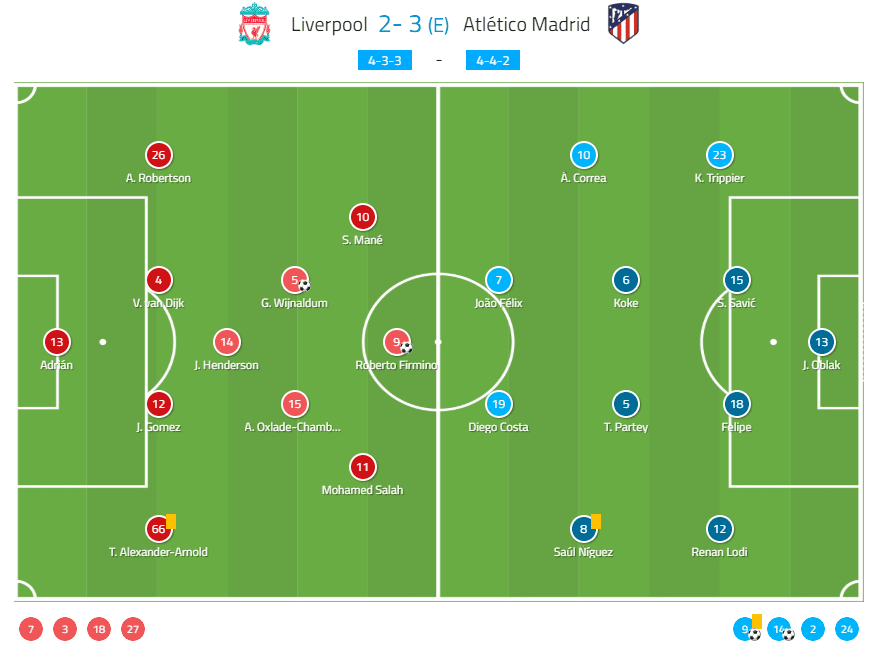
Liverpool lined up as expected with Adrián taking the spot of Alisson Becker in goal. Alex Oxlade-Chamberlain got the nod ahead of Fabinho whilst Jordan Henderson returned in midfield to provide a boost to the Reds, who went with their first-choice front three.
Atlético’s biggest surprise in the team selection was the decision to field Diego Costa in attack. Álvaro Morata’s knock from the weekend clash with Sevilla meant that he was reserved on the bench, with Ángel Correa being selected on the right of midfield.
Liverpool’s crossing
What was clear from this tie was that Liverpool would struggle to break down Atlético’s low defensive block. Much like the first leg, Liverpool could not find space in between the lines in order to exploit with the pace of the likes of Sadio Mané and Mohamed Salah. Instead, the team desperately turned to launching crosses into the box, an approach which equally failed to prove effective. With 52 attempted crosses, it was more than in any other game since Klopp took charge at Anfield.
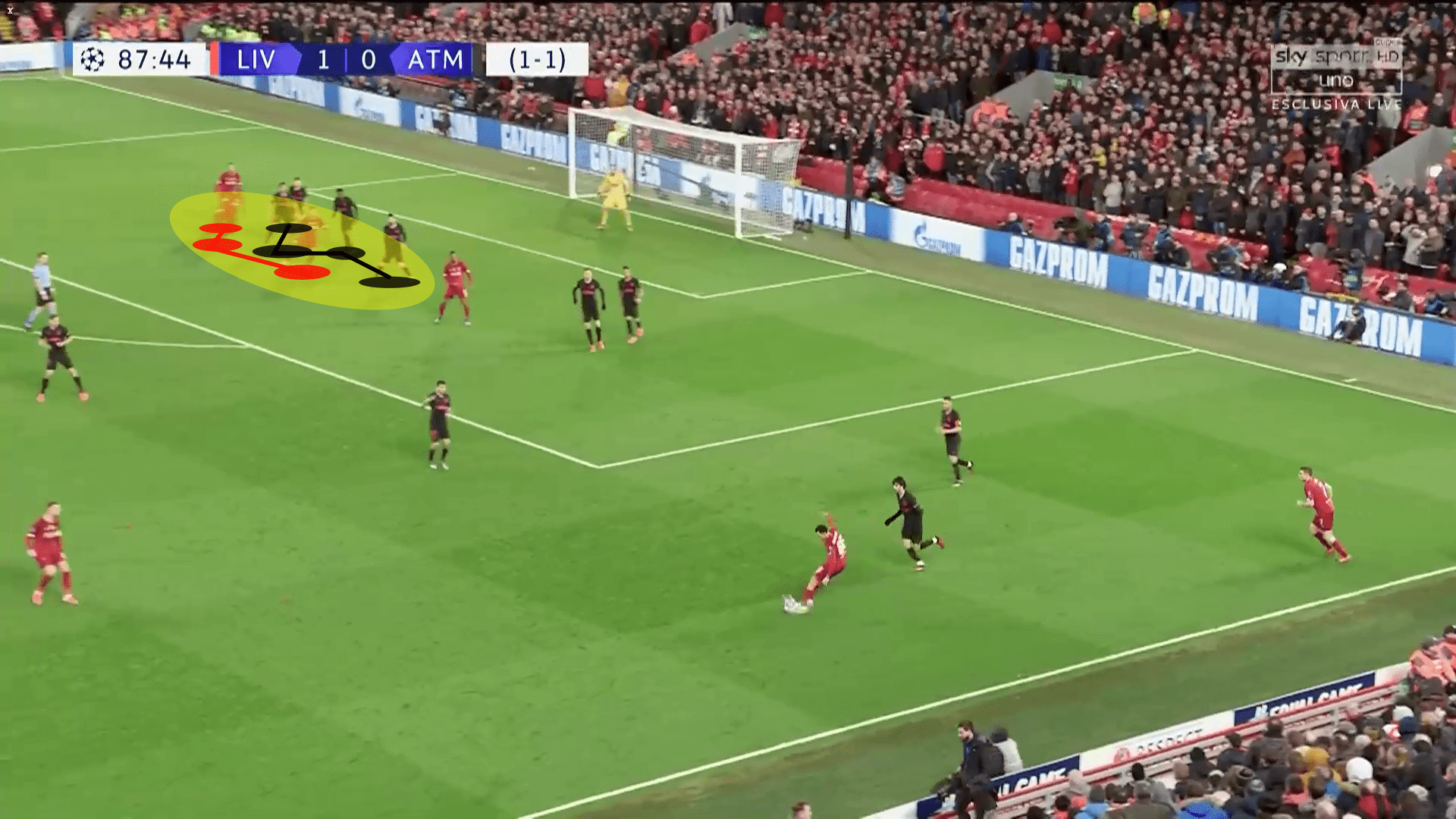
However, there appeared to be little planning to Liverpool’s approach of bombarding the Atlético box with crosses. Whilst they did get forward in numbers, with the likes of Virgil Van Dijk even coming up late on in the 90 minutes of normal time, there was little structure. The players would crowd around the penalty spot, but it was an easy approach for the Atleti defenders to handle, simply placing themselves goalside and looking to prevent any runs.
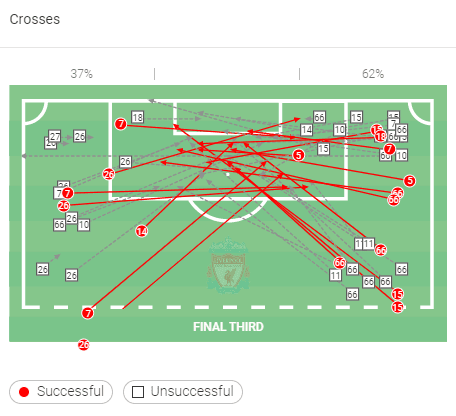
The desperation of this approach was clearest in the attempted crosses of Trent Alexander-Arnold. He, more than any other player, attempted many crosses from deep. Of his eight crosses from more than 20 yards out, he completed only two, yet persisted with this approach. In the end, it did not give Liverpool the quality chances they required often enough, with only three shots on target originating from crosses within the initial 90 minutes.
The role of Alex Oxlade-Chamberlain
What was particularly intriguing with Liverpool’s tactical set-up was the way in which Alex Oxlade-Chamberlain was used as the most offensive of the three-man midfield and was key in the link-up play on the right-hand side. He would act as the link between Alexander-Arnold and Salah, providing the connection to burst down the flank and create space or alternatively switch the ball to the opposite flank if there were no opportunities available down the right flank.
The key way in which he would do this would be to exploit the gap in between Thomas Partey and Saúl Ñíguez. Whilst they were close together and prevented him from getting the ball directly, the ball would instead go wide to Salah or Alexander-Arnold. This would drag Renan Lodi out, leaving a gap in the left-back position which Oxlade-Chamberlain would use his intelligence and pace to get there before either of the Atleti midfielders. This would allow him in to create space and exploit Lodi’s poor positioning and eagerness to press.
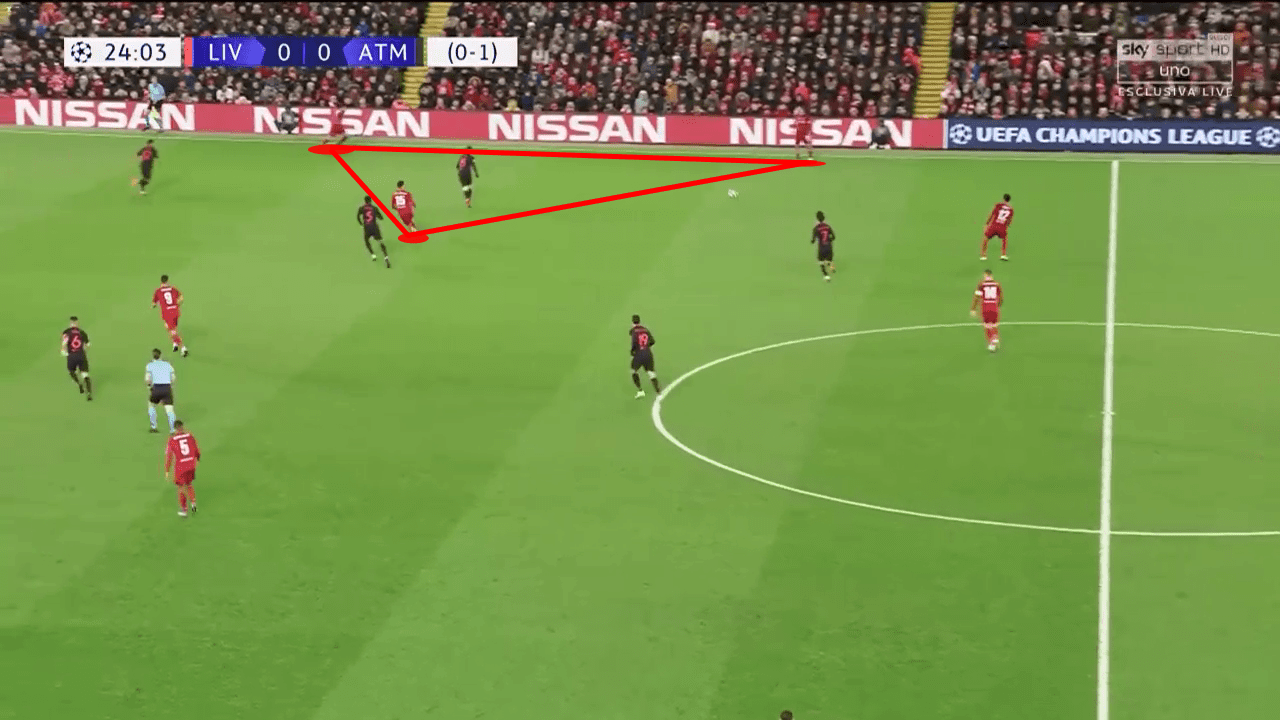
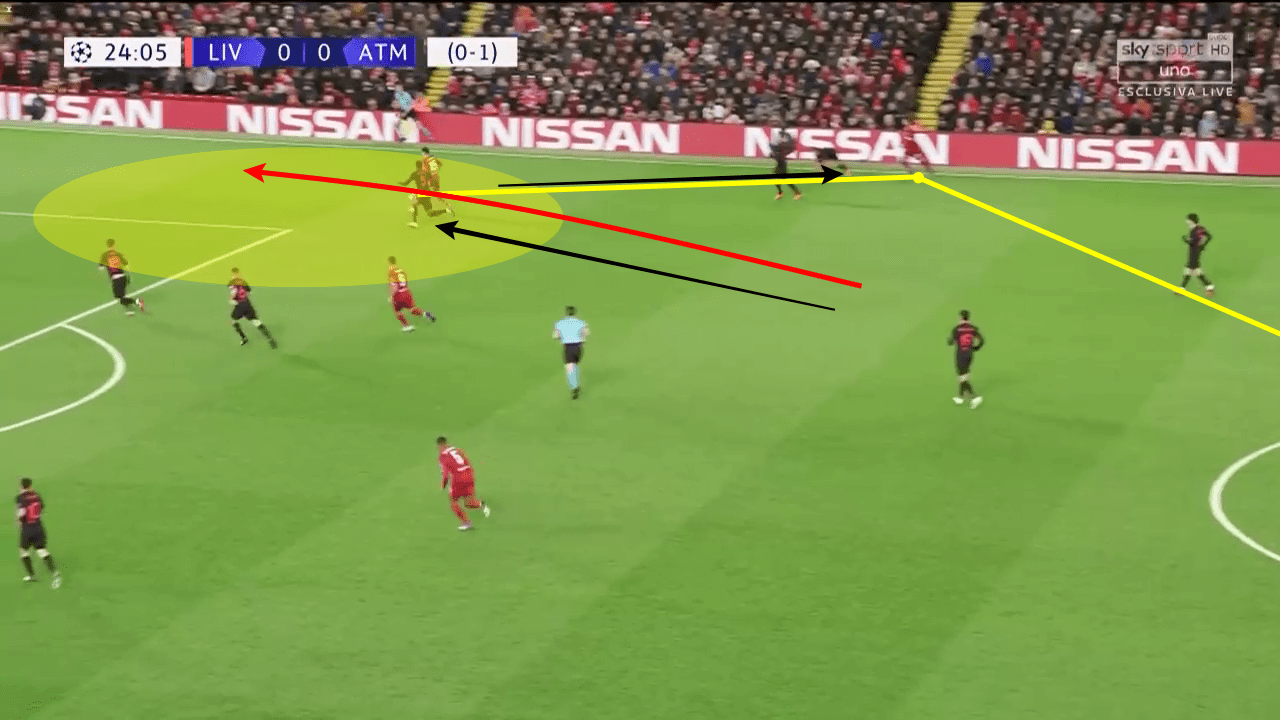
This approach was key to Liverpool’s game plan and it was no surprise that both of the Reds’ goals came from attacks down the right flank which would then be centred almost from the byline. It again reflects the frustration that Liverpool encountered with their crossing approach as they were so much more clinical when cutting back their crosses, yet the vast majority of their crosses came from deeper positions.
Simeone’s substitution
It’s fair to say that Atlético Madrid weren’t doing too much to threaten Liverpool in the opening stages of this encounter and didn’t do so until Simeone opted to make changes to his team. However, the change came when Llorente came on to replace Diego Costa. Whilst typically playing as a central midfielder, recent weeks have seen Simeone experimenting with the role that Llorente takes up, giving him more offensive responsibilities and that was again the case at Anfield.
Llorente took up the most advanced of the midfield roles, whilst also allowing Ángel Correa to step up from midfield to join Félix in the front line. With this set-up, there was more pace and dynamism to chase long balls and also to press with a greater intensity when Liverpool were in possession, no longer allowing them the comfort in possession that they had enjoyed throughout the two legs. Llorente would then step up almost as a third striker, filling the gap on the opposite flank, usually the left, in order to complete the press.
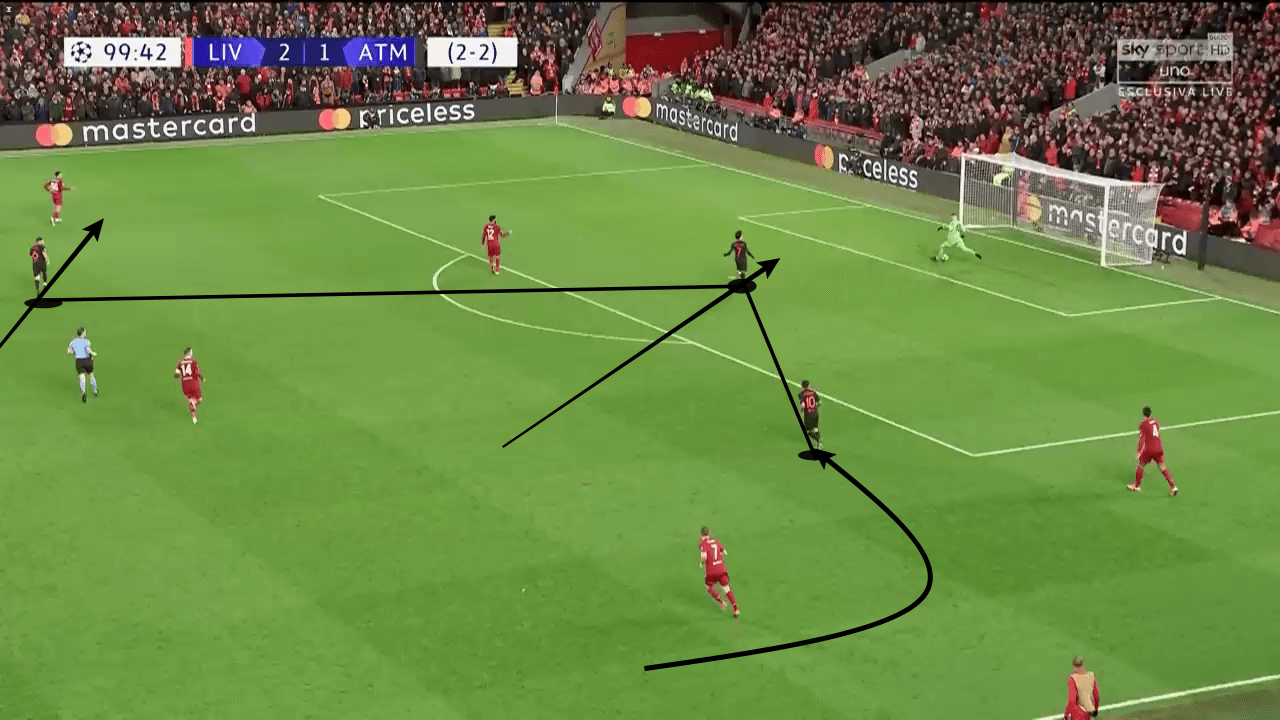
This important link with the front two was key to providing Atlético with an outlet which allowed them to have such an impact on the counter later on in the tie. As the game went on and Liverpool pushed more men forwards, Llorente could drop deeper accordingly and offer great flexibility to Simeone’s system. This role is a relatively new one, not used often by the Argentinian, but it has worked well with the former Real Madrid midfielder who has the stamina and fitness to do it. His impact at Anfield was clear and could bring a whole new element to this Atlético Madrid side.
Conclusion
Whilst some pundits claimed that this was no “masterclass” from Simeone, he set his team up to frustrate Liverpool perfectly. Given their xG of 3.08, Liverpool should still have been expected to win, even in the initial 90 minutes. They did more than enough to do so and had the chances to do so, but failed to show the clinical cutting edge that they have at other times this season. Atlético, on the other, did just what they haven’t done all season, and showed that clinical edge. With that, backed up by a spectacular performance from Jan Oblak in goal, meaning that the introduction of Llorente and the wasteful nature of the Liverpool attack was enough to secure a memorable win for Atlético at Anfield to put them through to the next round of the Champions League.





Comments